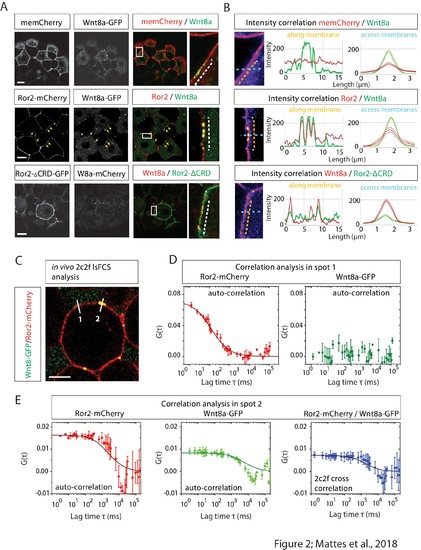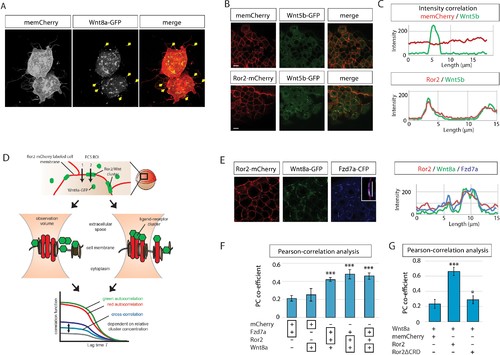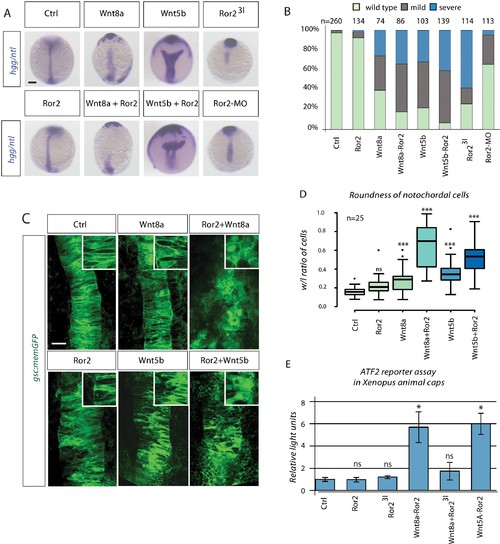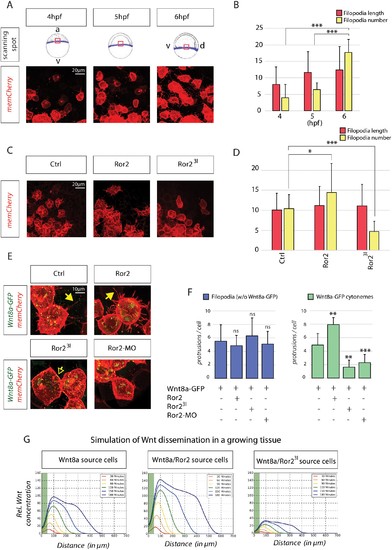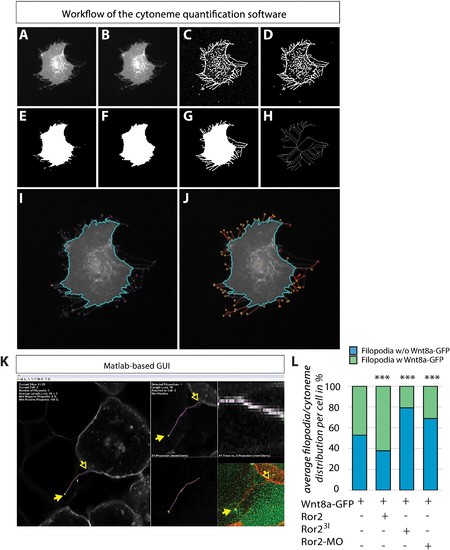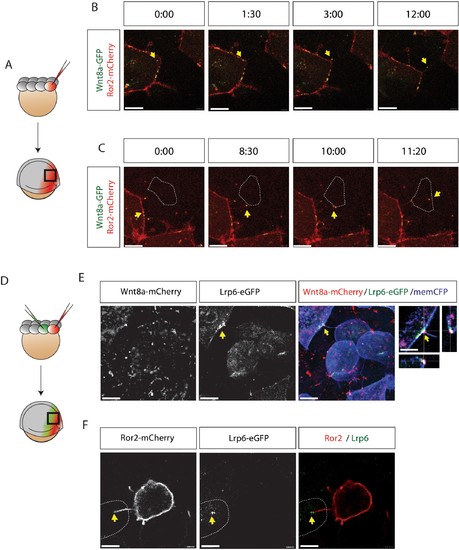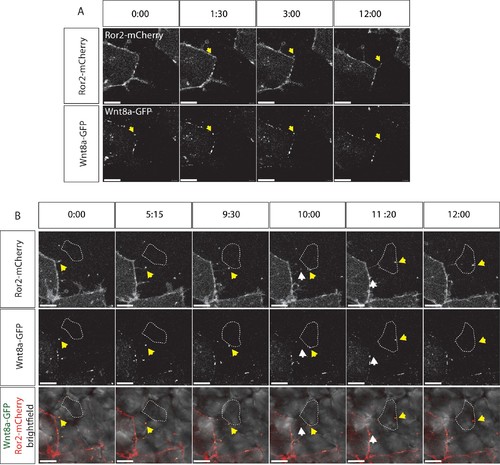- Title
-
Wnt/PCP controls spreading of Wnt/β-catenin signals by cytonemes in vertebrates
- Authors
- Mattes, B., Dang, Y., Greicius, G., Kaufmann, L.T., Prunsche, B., Rosenbauer, J., Stegmaier, J., Mikut, R., Özbek, S., Nienhaus, G.U., Schug, A., Virshup, D.M., Scholpp, S.
- Source
- Full text @ Elife
|
Image-based protein interaction analysis highlights Ror2s involvement in Wnt8a binding and cluster formation. (A) At the 8–16 cell stage, single blastomeres of zebrafish embryos were microinjected with 25 ng/µl mRNA of the indicated constructs to generate cell clones at 50% epiboly for confocal microscopy analysis. The imaging visualizes the co-localization of proteins in a single confocal plane including high-magnification of clusters. (B) A co-localization channel, obtained using fire LUT, and the intensity plot profile were generated in ImageJ. The intensity plots show one individual measurement along the membrane (left plot, orange arrows) and the average of measurements across the membrane including the SEM (right plot, light blue arrows). The graphs represents 10 membrane clusters acquired from five different cells of two different embryos per treatment. (C) Close-up of a 6–8 hpf live zebrafish embryos showing schematically how two-color two-foci line-scanning fluorescence correlation spectroscopy (2c2f lsFCS) data were collected by laser scanning perpendicular to the membrane (white lines) to collect data in the absence (spot 1) or presence (spot 2) of Wnt8a-GFP. Embryos were mounted in agarose and injected with Wnt8a-GFP and Ror2-mCherry. (D) Autocorrelation functions of Ror2-mCherry (red) and Wnt8a-GFP (green) (symbols) and model fit (line) measured in spot 1. The total time of the measurements was 390 s. Importantly, there is no Wnt8a-GFP at this position, as shown by the lacking autocorrelation in the green channel. Error bars represent standard deviations from two measurements. (E) Autocorrelation functions of Ror2-mCherry (red) and Wnt8a-GFP (green) and the dual-color cross-correlation (blue) (symbols) and model fits (lines) measured in spot 2. Here, Wnt8a-GFP is present, and a high cross-correlation amplitude indicates co-diffusion of bound Ror2-mCherry and Wnt8a-GFP. Error bars indicate standard deviations from two measurements. |
|
Ror2 binds to Wnt8a and Frizzled7a. (A) 3D confocal image of a cell clone at 50% epiboly. The embryo was injected with memCherry and Wnt8a-GFP. Cytonemes feature Wnt8a-GFP clusters at their tip (arrows). (B) Single confocal planes of embryos injected with Wnt5b-GFP and memCherry or Ror2-mCherry. (C) Intensity profiles along 15 µm of cell membrane containing Wnt5b-GFP spots, showing spatial intensity correlations with Ror2-mCherry. (D) Schematic depiction of the principle of line scanning fluorescence correlation spectroscopy (FCS) measurements, which allows us to remove fluorescence fluctuations that result from membrane motion. Red and green emitting laser foci are scanned perpendicularly through the plasma membrane. The emission is recorded as a function of time and corrected for membrane fluctuations. The autocorrelation functions of Ror2-mCherry (red excitation) and Wnt8a-GFP (green excitation) are computed from the intensity time traces and yield local concentrations (i.e., area densities) and diffusional correlation times. The cross-correlation between red and green is a measure of joint intensity fluctuations in the two channels caused by Wnt8a-GFP bound to Ror2-mCherry diffusing together through the excitation focus. (E) Diagram of confocal planes of embryos injected with Wnt8a-GFP, Ror2-mCherry and Fzd7a-CFP and the corresponding intensity correlation. (F, G) Pearson correlation coefficients of pairs of fluorescent proteins in a dual-color image (as indicated by the black boxes below the bar graph). The result is +1 for perfect correlation, 0 for no correlation. (F) Analysis of confocal images of embryos at 50% epiboly injected with the indicated constructs, as determined by Imaris software. (G) A Pearson co-localization analysis of the indicated fluorescent constructs in a tissue volume of 40 × 40 × 60 µm3 of eight different embryos. ***=P<0.001. |
|
Synergistic Wnt PCP activation by Wnt8a and Ror2 in zebrafish and Xenopus embryos. (A) Embryos at 11 hpf were fixed and subjected to in situ hybridization against hgg/ntl. Scale bar represents 200 µm. (B) Embryos were sorted into groups according to their phenotypes (see Figure 3—figure supplement 1 for details). (C) gsc:memGFP embryos were microinjected with the indicated constructs, fixed at 11 hpf and a defined z-stack was imaged by confocal microscopy. The confocal stack shows the notochord marked by gsc:memGFP from a dorsal view with the animal site to the top. Magnified insets highlight the shape of the notochord cells. Scale bar represents 20 µm. (D) Analysis of cell roundness. The boxplot shows the width/length ratio of 25 notochordal cells. Circularity ranges from 0 (infinitely elongated polygon) to 1 (perfect circle). ANOVA confirmed that cell roundness is significantly different in the analyzed groups with p=2.91*10−24, confidence interval 95%, F value=37, and df=149. (E) ATF luciferase reporter assay of pooled Xenopus gastrulae injected with the indicated constructs and the ATF2 firefly and Renilla luciferase reporter. Data shown are the mean with SD of three independent experiments. ***=P<0.001, **=P<0.01, *=P<0.05, ns, not significant. EXPRESSION / LABELING:
PHENOTYPE:
|
|
Analysis of convergent extension phenotype in zebrafish development (A) Microinjection of Ror2-mCherry mRNA in rising concentrations and classification of phenotypes into groups showing developmental alterations at 24 hpf. A Chi-squared test was performed to determine the p values. (B) Classification of embryos into three groups of phenotypes depending on their ntl expression. (C) Quantification of the ntl expression width. Location of the measurement is shown in the left image (dorsal view, animal to the top) and the bar diagram represents average width with SEM. ***=P<0.001, *=P<0.05. |
|
In-depth analysis and simulation of Wnt-positive cytonemes in zebrafish embryos in vivo. (A) Live confocal microscopy analysis of filopodia dynamics over time. Mosaic expression of memCherry was utilized to quantify the protrusions of single cells at the indicated positions. The image shows the same cells at different times during zebrafish gastrulation. (B) Filopodia of cells in (A) were measured using semi-quantitative segmentation software (see Figure 4—figure supplement 1 for details). Quantification illustrates the mean filopodia length and the number of filopodia per cell with SEM at different time points. (C) Effect of Ror2 on filopodia length and number. Live confocal microscopy analysis of the filopodia of embryos injected with Ror2 or Ror23I mRNA at the one-cell stage. (D) Diagram of mean filopodia length and number per cell with SEM. (E) Analysis of Wnt cytonemes during live imaging. Embryos were microinjected at the 16-cell stage to generate a cell clone expressing Wnt8a-GFP and memCherry to visualize cytonemes and the Ror2, Ror23I or Ror2-MO oligomer. Confocal images of single cells were taken and subjected to filopodia length/number measurement. See Figure 4—figure supplement 1 for stacked diagrams with chi-squared test analysis. (F) Bar diagram showing the number of filopodia without Wnt8a-GFP (i.e. GFP signal below detection limit) or filopodia carrying Wnt8a-GFP (cytonemes) (i.e. GFP signal above detection limit) per cell. Statistical analysis ***=P<0.001, **=P<0.01, *P<0.05. Data meet the assumptions illustrated in (B) that filopodia length and number are significantly different at the analyzed time-points (One-way ANOVA, p=1.35*10−9, confidence interval 95%, F value=27.6, and df=73) and in (D) that the filopodia number and length are significantly different across treatments (p=1.61542*10−7, confidence interval 95%, F value=24.6, and df=39). (G) Simulation of Wnt dissemination in a growing tissue over 180 min. Wnt8a is distributed in a graded manner in the target tissue. Modeling the dynamically expanding tissue with single-cell resolution and discrete implementation of cytoneme-based transport establishes a morphogen gradient over the length of the developing tissue. On the basis of the cytoneme appearance measured in (D) and (F), Ror2 activity in the Wnt-producing cells alters the input of Wnt in the target field, which is directly incorporated into the simulation by altering the formation frequency of cytonemes and thus ligand concentration in the neighboring tissue. Simulated time in minutes after the onset of Wnt production at 4 hpf. |
|
Cytoneme quantification software toextract filopodia automatically using the memCherry channel of the acquired images. The raw image (A) was initially smoothed with a Gaussian low-pass filter (B) to reduce image noise for facilitated processing. To emphasize the filopodia in the image, we used an objectness filter that emphasizes line-like structures based on the eigenvalues of the Hessian matrix (C) and that binarized the resulting edge image (D) using local adaptive thresholding. For the detection of the cell body, we applied a local adaptive threshold to the Gaussian smoothed raw image (E) and performed a morphological opening operation to remove filopodia remains from the cell body (F). The two binarized images (D) and (F) were then combined to yield the final segmentation mask including cell body and filopodia (G). Finally, the combined binary image (G) was used to obtain a skeleton image (H), which in turn allows the extraction of potential filopodia tips at the end points of the skeleton. The identified cell body (cyan outline) and the potential filopodia tips (magenta dots) are shown in (I). A livewire approach was then used to automatically trace filopodia from the tips to the cell body (J, red lines). (K) To measure and analyse filopodia in acquired 3D images, we developed a custom-made MATLAB graphical user interface (GUI) that allowed us to scroll through the slices of the stack and to trace filopodia semi-automatically on the basis of the manually provided start and end points of a filopodium of interest (yellow arrows). The software automatically traces the filopodium in 3D using a livewire approach to obtain accurate length quantifications. The software also keeps track of all segmented filopodia, provides filopodia counts and length measurements, and provides average quantifications of all identified filopodia. In addition, in a window of the GFP channel, we were able to distinguish between Wnt-positive and Wnt-negative filopodia for embryos expressing Wnt8a-GFP. |
|
Visualization of Ror2-Wnt8a cytonemal transport and Lrp6 receptor clustering in the living zebrafish. (A) Illustration of the injection procedure to generate single cell clones. (B–C) Time series of a single confocal plane of Ror2-mCherry/Wnt8a-GFP-expressing cells to (B) observe Wnt8a recruitment to the membrane and cytoneme initiation and (C) cytonemal target finding and Ror2/Wnt8a cluster endocytosis into the receiving cell. Optimal microscopical settings were used to allow an improved axial resolution of ca. 250 nm. Single channels in Figure 5—figure supplement 1A,B and Figure 5—video 1. Yellow arrows indicate the Wnt8a/Ror2 cluster and highlights pruning of the cytoneme tip after successful cytonemal delivery. Yellow arrows mark the Wnt8a/Ror2 cluster. (D–F) Wnt8a-mCherry cytoneme leads to Lrp6-GFP accumulation and co-localization at the receiving cell. (D) Illustration of the injection procedure used to generate clones to visualize paracrine signal transport. (E) 3D-stack of a Wnt8a-mCherry cytoneme leading to Lrp6-GFP accumulation and co-localization at the receiving cell. The close-up shows a single plane including orthogonal YZ and XZ views of the cytoneme contact point. (F) Single-plane image of a Ror2-mCherry/Wnt8a cell leading to Lrp6-GFP clustering on the cytoneme contact site. Scale bars = 10 µm; in E = 20 µm. |
|
Visualization of Ror2-Wnt8a cytonemal transport in the living zebrafish. Time series of still pictures of single channels of Ror2-mCherry/Wnt8a-GFP-expressing cells to observe (A) Wnt8a recruitment to the membrane and cytoneme initiation and (B) cytonemal target finding and Ror2/Wnt8a cluster endocytosis into the receiving cell. White arrows indicate the Wnt8a/Ror2 cluster whereas the yellow arrows highlight pruning of the cytoneme tip after successful cytonemal delivery. (B) A series of merged pictures with the bright field channel are included in this panel. Scale bars = 10 µm; in (E) = 20 µm. |
|
Ror2 enhances paracrine Wnt/β-catenin signaling in zebrafish embryos and HEK293T co-culture. (A) Microinjected embryos at the indicated stages were fixed and subjected to in situ hybridization against the Wnt target gene (axin2) or against markers for brain patterning (fgf8a, pax6a). Brackets indicate the expansion of Wnt target gene expression (axin2), distance of fgf8 expression domains or forebrain territory (pax6a), while asterisks indicates a lack of forebrain tissue. (B) Co-culture reporter gene assay in HEK293T cells. The TCF/Wnt reporter population was transfected with 7xTRE Super TOPFlash-NLS-mCherry and Lrp6 and co-cultured with a second population as indicated. The co-culture principle is illustrated in Figure 6—figure supplement 1. (C) Relative reporter activation by measuring the mCherry signal. The bar chart shows the mean value with SEM of three independent experiments. Scale bar represents 200 µm. (D) RT-qPCR-based expression assay in zebrafish embryos. Embryos were injected at the 16-cell stage to generate a distinct signaling center at 75% epiboly (see Figure 6—figure supplement 1 for details) and were subjected to RTqPCR. Relative ΔΔCt expression values of Wnt-β-catenin target genes axin2 and lef1 are acquired by normalization to actb1 and in comparison to a control-injected sample (relative ctrl expression level shown as a dotted line). Each condition represents the mean Rt-qPCR result of 4 × 50 embryos acquired from two independent experiments. *** P < 0.001, * P < 0.05. ANOVA confirmed the hypothesis that expression levels are different between treatments with a p=0.00025, confidence interval 95%, F value=33.9, df=11. |

